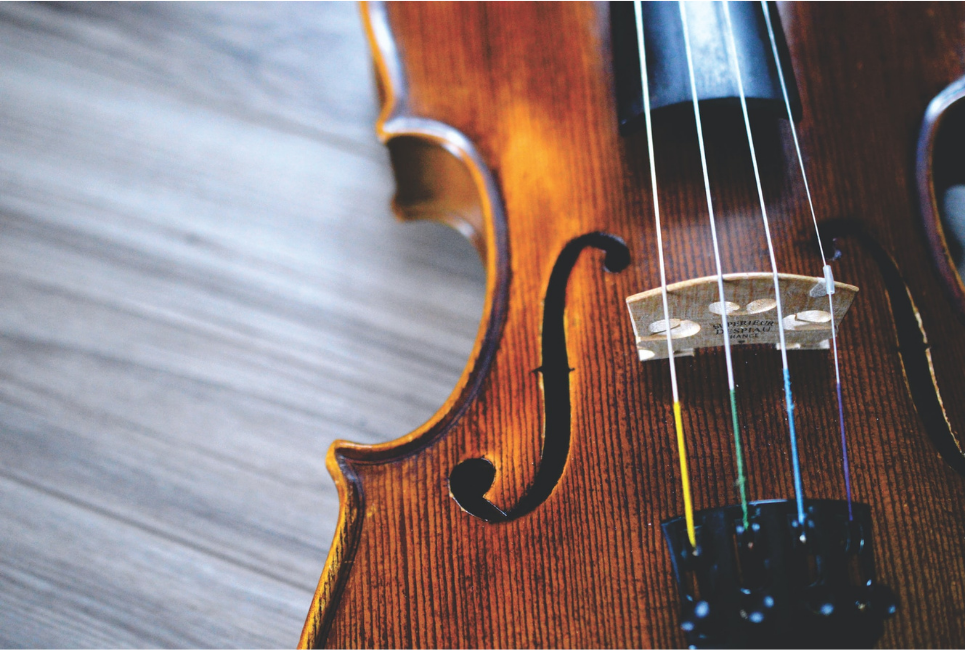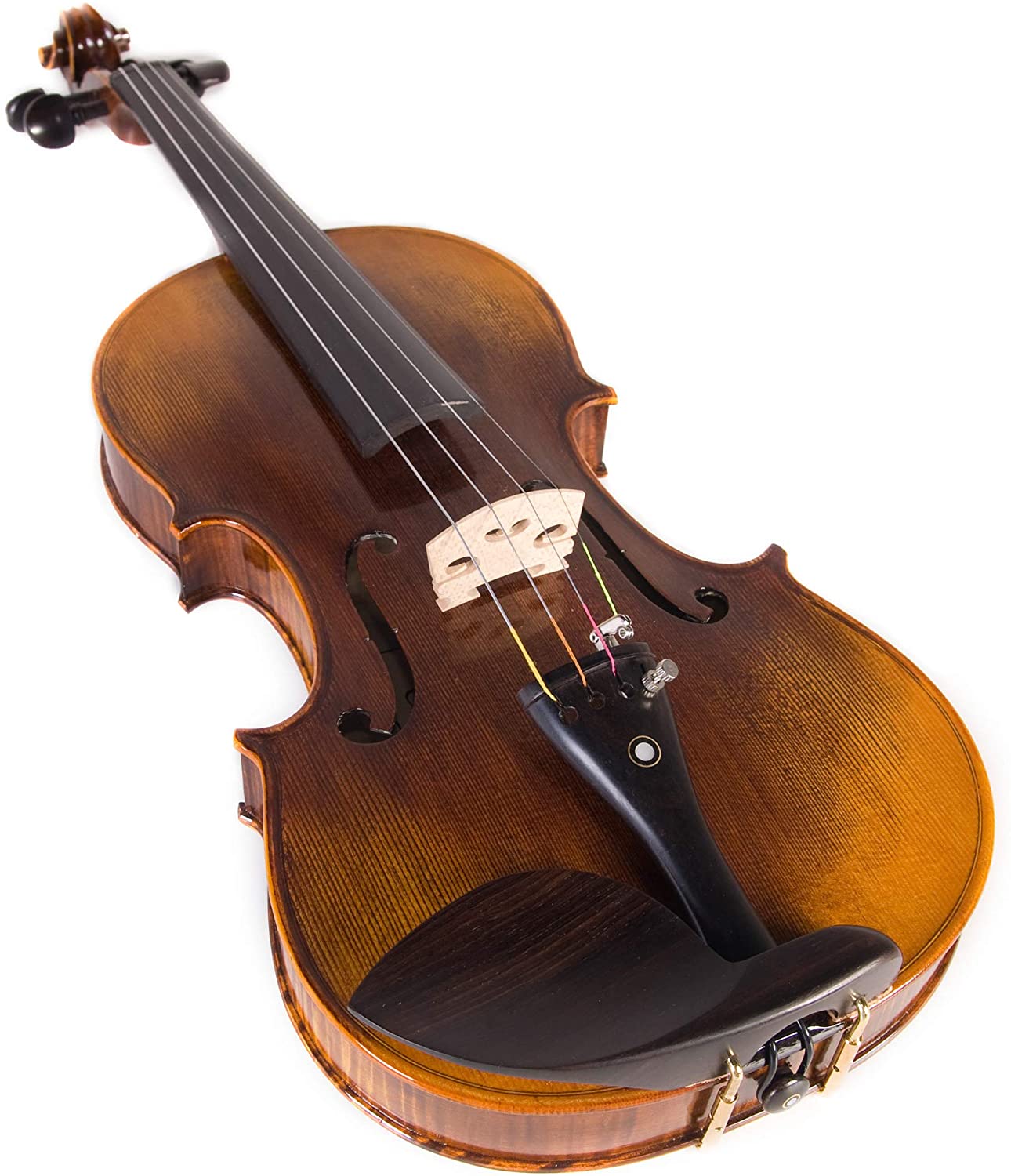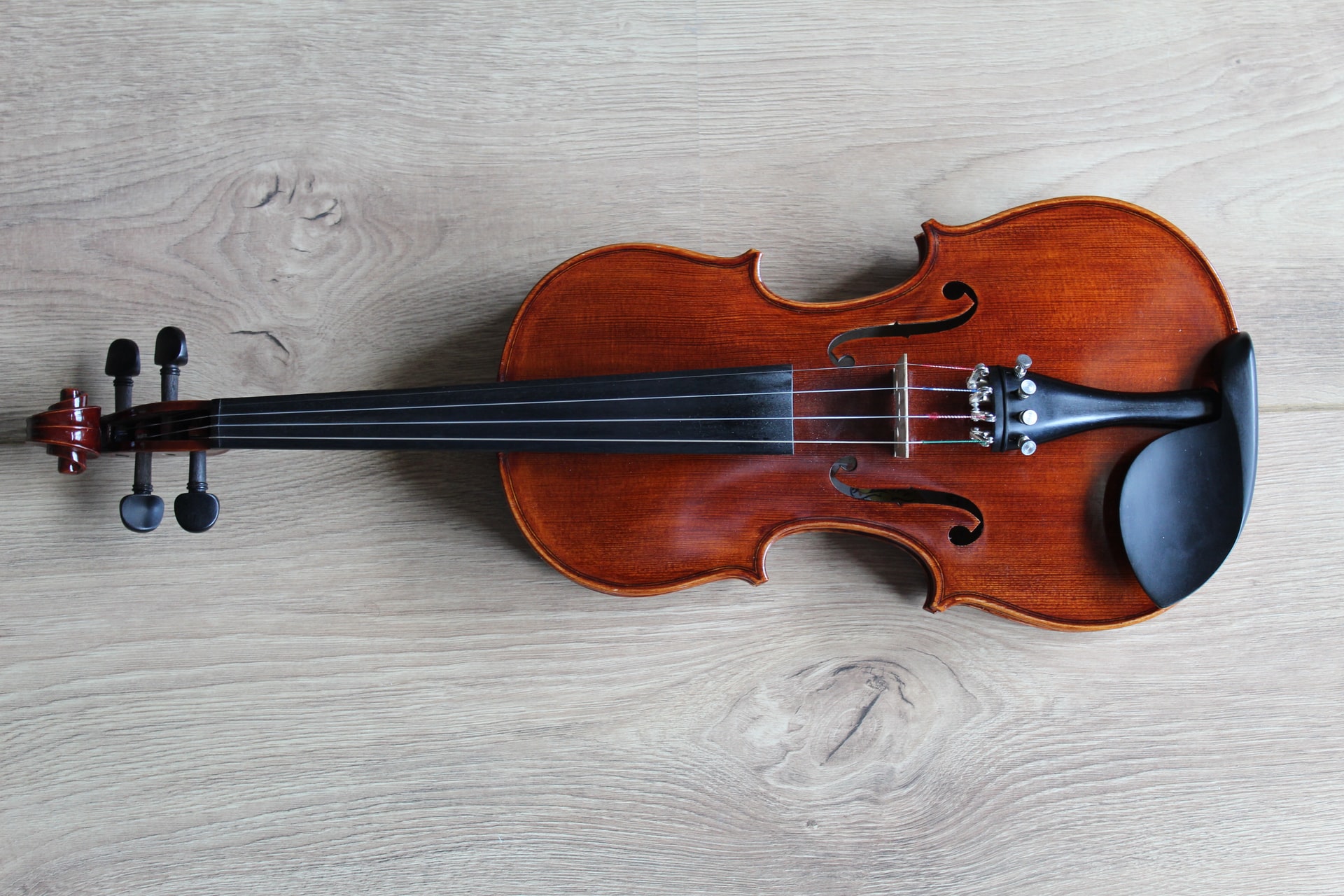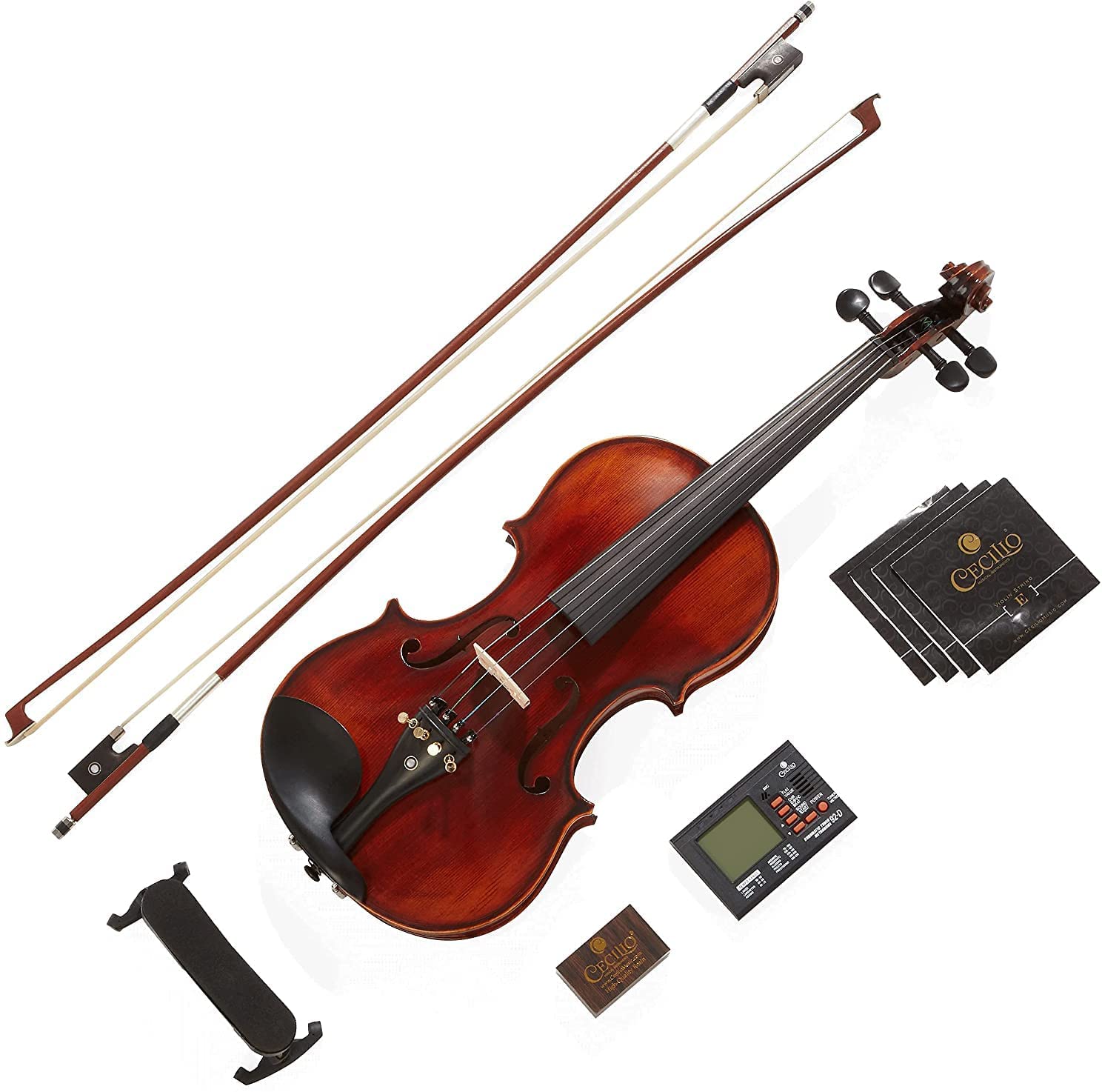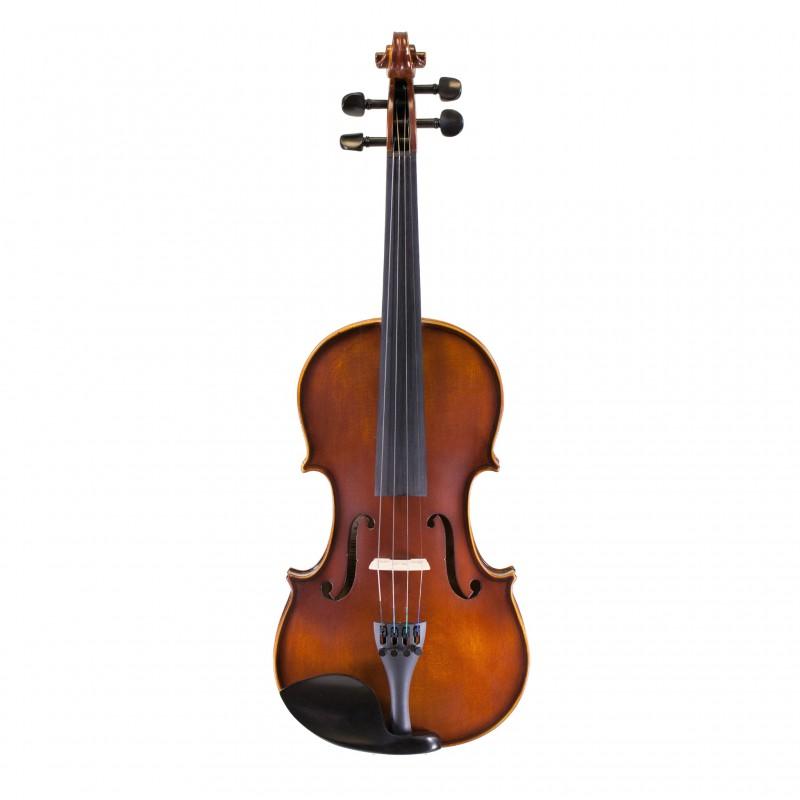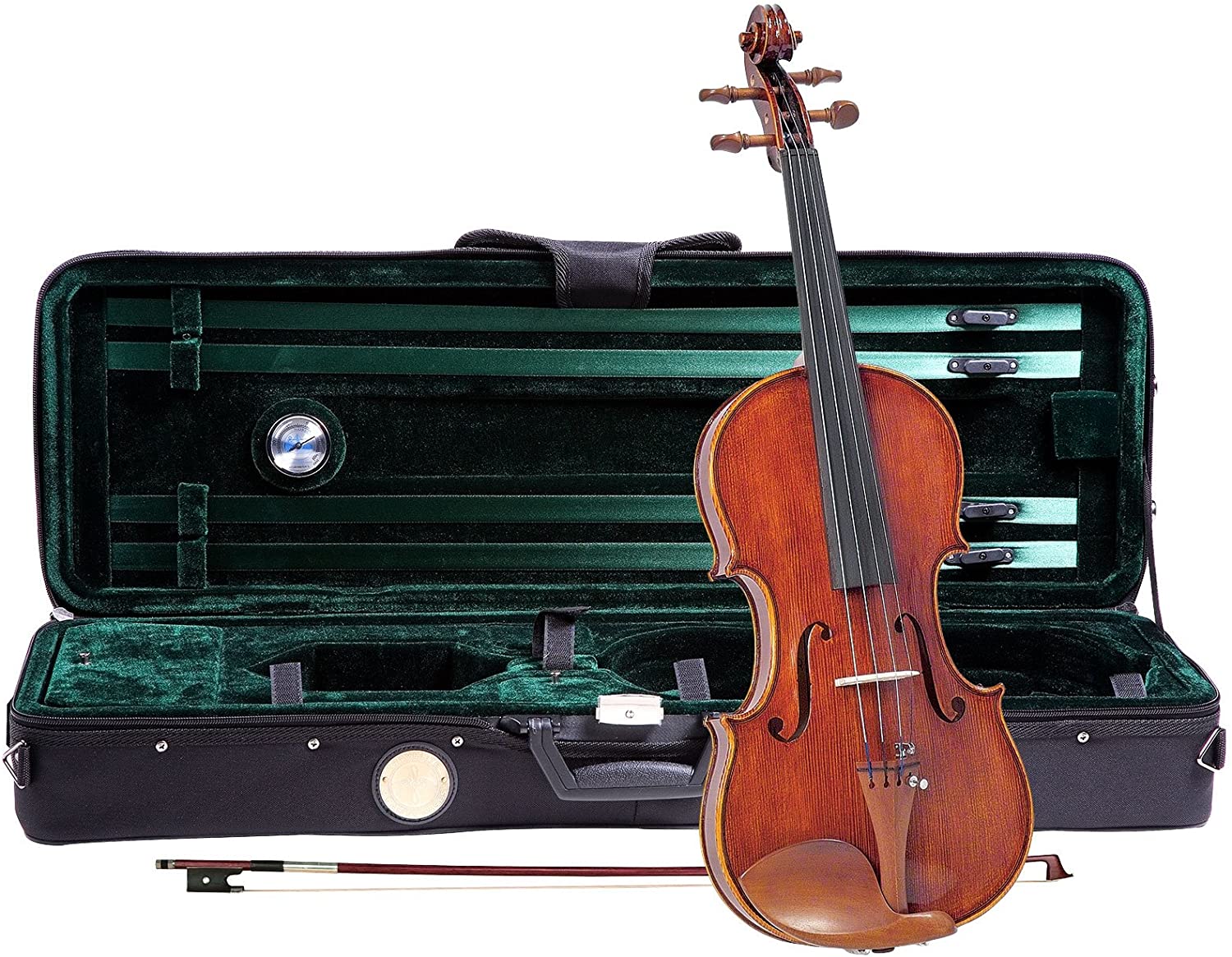- Mendini MV300: An Honest Breakdown and Review - April 6, 2022
- Cecilio Viola Review and Guide: 3 Violas, Which is the Best? - January 21, 2022
- Cecilio Electric Violin Review and Guide: A Silent Practice Violin! - January 20, 2022
Finding a quality violin in a cheap package is a serious struggle. While there are a lot of cheap violins out there, there are not a lot of cheap quality violins out there. Furthermore, even if you do find a quality cheap violin, it is likely an instrument that doesn’t give a student enough room to grow in their skills before requiring an upgrade. The Cecilio CVN-600 combines quality, room for growth, and a cheap retail price.
Pros and Cons of the CVN-600 Up Front
Pros
- Has a clear, balanced tone that focuses on clarity in the upper register and warmth in the lower
- Aged solid carved tonewoods
- Hand-applied oil-based varnish
- 1 piece maple back
- Upgraded case and strings
- Full outfit with all accessories
Cons
- Will need set up by a luthier adding to the overall cost
- Bows that come with the violin are of poor quality and will need upgraded
What I Look For In a Violin
When looking for a new violin, you need to pay special attention to various aspects of the instrument. When looking online, you want to look for specific information in the instrument listing. What you are looking for or what you will need out of your instrument will change depending on the level you play at. The Cecilio CVN-600 is a student model instrument, so we will focus only on student instrument criteria. Fortunately, these criteria are met by many student violins you can find online.
Materials & Construction
- Tonewoods on student instruments can either be aged or unaged; the important thing is that the violin is made with a solid carved spruce top and solid carved maple back and sides. The keywords solid carved are really important. Cheaper instruments may use pressed wood instead of solid wood. This significantly hinders the tone and playability of the instrument. Spruce and maple are traditional tonewoods that are used for their ability to carry sound waves properly. Maple is used in violins because it is durable and sounds bright. Lastly, the instrument’s back is often carved from two pieces of wood glued together instead of just one because of how skinny spruce trees grow. However, some instruments can be found with a one-piece back; theoretically, this means the back is more durable, and it can also affect the instrument’s overall tone. How much the instrument is affected by this rare change will depend on the overall quality and age of the instrument.
- Fingerboards are another very important aspect of the violin. Fingerboards are traditionally made out of ebony wood, a very hard and durable wood that is capable of withstanding oil and dirt from fingers and hands. On cheaper student violins, you will often see a maple fingerboard. This isn’t the worst thing because if you have a violin of that low quality, you will need to upgrade before the fingerboard has a chance to see wear. However, it’s still not ideal if you want a violin that you can continue to use for more than a year or two. If you see a violin that doesn’t specify the type of wood used for the fingerboard or says “dyed hardwood or hardwood fingerboard,” I would skip that instrument entirely since you can’t be sure of the materials used or the quality.
- Fittings include tailpiece, pegs, endpins, and chin rest, and they can be made from various woods. I’m partial to the look of pure ebony fittings on a student violin. Still, you will see boxwood and maple often on student instruments as well. As you expand your knowledge of instruments and experience different styles, you will find all sorts of fitting woods used; the weirdest I’ve seen is snakewood. I’m currently changing my fittings from traditional ebony to rosewood to refresh the look of my violin.
- Tailpieces are technically part of the fittings package, but they can vary on student instruments. Traditionally you will find ebony or a composite tailpiece with four fine tuners. This is very important for students as fine tuners help them achieve a precise tune. I’ve been playing for 7 almost 8 years, and I still use my fine tuners for certain violins. If fine tuners aren’t your thing, you can look into geared pegs for your violin. I have planetary pegs going in my acoustic violin, and I’m excited to try them out!
- Varnish is the last big item on my list. Student instruments often have a thick lacquer style varnish that is very heavy. I find that it can dull the instrument’s tone and contribute to its weight. I prefer a hand-applied varnish or at least one that is thinner and lets the true detail of the woods look and tone shine through.
- The outfit and accessories are an important part of student instruments. Traditionally your first violin will come with all the basics you need to get started. This means you will receive a violin with strings installed and at least a case and a bow. More than likely, you will receive extras like rosin, a shoulder rest, tuners, and even music books. The bow, case, and strings are the most important aspects that will either need to be of good quality or replaced quickly. The bow especially will need to be well balanced and not warped.
How Does the CVN-600 Compare
The instrument itself blows me away in terms of price, but I find most of the accessories to be lacking as a whole. Still, the value is purely in the instrument at this level, and the accessories can easily be upgraded.
Materials & Construction
- Tonewoods: The tonewoods selected for this violin model are amazing for the price. Featuring hand-carved wood that has been aged over seven years with high a highly flamed one-piece solid grained maple back and solid grained spruce top. The one-piece maple back on this violin isn’t the biggest deal since this violin is factory-made, but it is a nice step up that shows the quality. The violin body also features inlaid purfling, but it is unclear whether it is hand inlaid or machine inlaid. Some videos mention it being hand-inlaid.
- Fingerboard: The fingerboard on this violin is pure ebony, perfect for a violin of this price point. It’s also perfect for the growing student as the fingerboard will stand up to wear for many years. There is no mention if the fingerboard is machine or hand-planed so I’m assuming machined. At this price point, that is actually perfectly fine. Still, I’d have it double-checked by a luthier as occasionally Cecilio violins come with wonky fingerboards that are measured properly.
- Fittings: The fittings on this violin are made from pure ebony, as you would expect on a violin of this price point. The tailpiece has 4 detachable fine tuners and a mother of pearl inlaid for decoration. The fine tuners are basic ones, although this violin came with gold plated tuners at one time, which made the violin look extra fancy. You can detach the fine tuners, so you only have one on the E string if you want. Four fine tuners are standard on student violins, but as you progress, you will find you only want one on the E string as you tune your strings with the pegs most of the time.
- Varnish: The varnish on this violin is oil-based and hand-rubbed, making for a beautiful finish. This type of finish meshes well with the violin’s tone and really lets the wood quality shine.
- Outfit and Accessories: The outfit comes with all the accessories you need to get started.
- Case: I’m particularly impressed by the shape and style of the violin case and the fact that it contains a hydrometer. It’s great quality, and this violin deserves a great case like this! The case also contains at least one large carrying pocket for rosin, mutes, and your shoulder rest. There are two bow holders as well.
- Bows: This is the one area that I find this outfit lacking. The bows included are two basic Cecilio models. Cecilio bows have a nasty habit of warping or being off-balanced. I’d highly suggest upgrading to a carbon fiber bow or at least a better quality brazilwood bow.
- Strings: This violin comes strung with D’Addario Prelude strings which are basic steel core student strings. For a student, this is standard and perfectly acceptable. Still, I’d recommend upgrading to different strings for someone who is advancing. I’m a fan of Fiddlerman Strings or Thomastik Dominants myself. Evah Piastros are another favorite if you really want to go all out on strings.
- Everything Else: This violin outfit comes with a lot of accessories, including rosin, a shoulder rest, tuner, and lesson book. All of these things are decent quality, but you may find yourself needing a different music book or wanting an upgraded shoulder rest in the near future.
What Does the CVN-600 Sound Like?
This really is the big question; we know what the violin is made out of, but what does it sound like. If you want to hear the CVN-600 for yourself, you can check out this video by Alison Sparrow, the Online Piano, and Violin Tutor.
Personally, I found the violin to have a bright, balanced tone. I particularly find the upper register to sound very clear and bright. The lower register sounds rather muddy, but with a few string changes and some experimentation, I’m sure the G string would start to sing as well. Overall this violin has a great tone for a student that will only continue to grow and get better. This is the type of violin you can grow with, not just outgrow. I’d give this violin at least six months to really settle in; at that point, you will start to notice the violin gaining its own personality.
Other Violins to Check Out
Mendini MV500/650
Mendini MV500/650 is a cheaper yet top-quality Violin from Cecilio’s child company Mendini. The MV500/650 has the same features as the CVN-600 but doesn’t feature aged wood. This brings the price down considerably, but it does mean that this violin doesn’t have as much personality at first. Still, it’s worth getting as a starting instrument for the price point. You’ll be off to a better start than buying one of the cheaper instruments in either Cecilio or Mendini’s line.
Fiddlershop’s Tower Strings Entertainer Violin Outfit
Fiddlershop’s Tower Strings Entertainer Violin Outfit is a great choice for a starting violinist. Featuring solid carved tonewood dried for at least 2 years, a hand-carved bridge, and 100% ebony fittings. The violin outfit comes with everything you need including a bow, case, shoulder rest, rosin, practice mute, polishing cloth, and tuner.
Cremona SV-1260
Cremona SV-1260 is a great step up or intermediate violinist for a serious student. It is a great deal more expensive than the CVN-600, but it’s a beautiful choice and will stay with a student for a long while. This violin features a hand-carved solid spruce top and hand-carved one-piece flamed maple back and sides. The fittings are boxwood, and the violin is strung with Anton Breton VNS-150 Perlon strings. The fingerboard is pure ebony. The violin outfit comes with a deluxe case and brazilwood bow.
FAQ
Answer: The bridge comes installed, so it doesn’t get bumped and potentially damage the violin. I find this annoying as it means an extra trip to the luthier for a proper setup. However, I understand the need for it. Some violin companies can ship their violins fully set up using specific shipping methods to ensure the bridge stays properly.
Answer: This violin was made in China and re-set up in Cecilio’s Los Angeles workshop. Cecilio promises that they re-test all of their instruments for the highest quality.
Answer: Cecilio offers a wide variety of band and orchestra instruments, from other string instruments to woodwinds and percussion.
Answer: This will largely depend on your goals. If you want to play with famous Orchestras, you’ll want to upgrade in three to five years. If you don’t have specific goals and just play for fun, this violin could last you a decade or more. Those who fall somewhere in the middle will find this violin will last at least five years.
Final Thoughts
The Cecilio CVN-600 blows me away in terms of quality for the price. For less than 500 dollars, you get a beautiful violin with aged tonewoods and full ebony fittings. Along with all of the accessories, you need to get started!! If you are looking for a student violin or bought a cheaper Cecilio, Mendini, or equivalent and want to upgrade to something that will give you more longevity, then this is it! You’ll be able to go far on this violin and refine your skills. When you are ready to upgrade, you’ll know exactly what you need and want out of an antique or expensive violin.
Looking for more interesting readings? Check out:

